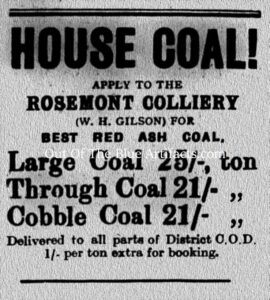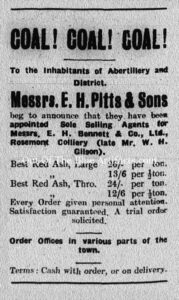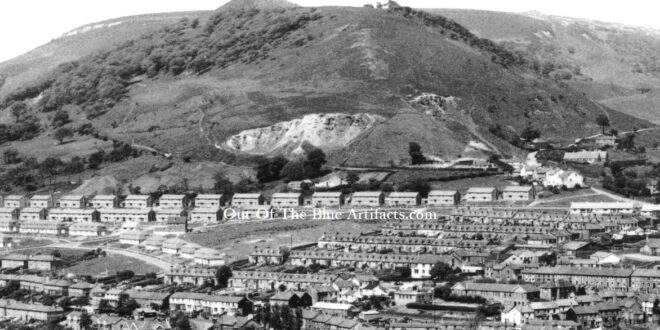Rosemont Coal Level – Clyn Mawr.
The Rosemont Coal Level was situated on the southern end of Mynydd James just behind the Clyn Mawr Uchaf Farm. It mined coal from beneath the lower part of Mynydd James with the workings extending up past Ty-dan-y-Wal and the Rising Sun to where the Cwmtillery Top Rows were.
The Blaina Iron and Colliery Company.
The Rosemont Colliery was originally owned by the Blaina Iron and Colliery Company.
 Mr W. H. Gilson.
Mr W. H. Gilson.
In the 1922 the colliery was taken over and owned by Mr William Henry Gilson.
Mr William Henry Gilson was born in 1874 at Tredegar, Monmouthshire he married Miss Margaret Gilson nee? and lived at 93 Alma Street Abertillery. Mr Gilson had been a miner working in the coal levels since 1896. He and his wife later moved to Ashvale House on Rose Heyworth Road, Abertillery. In 1923 they had sold Ashvale and moved into Newtown Cottage on Rose Heyworth Road, Abertillery.
The Coal Screens Application.
In 1929 Mr W. H. Gilson applied to the council for planning to erect coal screens on the Rose Heyworth Road though there was much opposition to this from the many people who used to walk along the road who said it would ruin the scenery.
The Pit-Prop Patent.
In May 1932 it was reported that Mr W. H. Gilson had patented a type of pit-prop. The prop was of a knuckle-joint design which could be removed without danger to the workmen, it was said it could be extended to any length and a crossbar was provided which would cut out the need for double timbering.
 Messrs E. H. Bennett & Co.
Messrs E. H. Bennett & Co.
In August 1930 the colliery was sold to Messrs Bennett & Co who were owners of collieries in South Wales and the North of England. The new manager was Mr H. Johns, a mining engineer of Brynmawr. It was stated that the services of Mr Gilson was to be retained in a managerial role. Messrs E. H. Pitts & Sons were agents for the new company.
The Rosemont Colliery Levels employed 30 to 40 men and the coal mined was used for the production of gas in the county.
The Main Photograph.
The image above is of the Rose Heyworth Housing Estate and Blaenau Gwent. The mountain at the (center) is Mynydd James locally known as the “Cock n Chick” Mountain, under which the Rosemont Coal Levels were driven. The top row of houses is Attlee Avenue. In the (center of the image) behind the Attlee Avenue (center left) were the Rosemont Coal Level entrances and waste tips.
In the (center of the image) can be seen the new opened-out stone quarry, with which the stone was used to build the garden walling throughout the Rose Heyworth Estate. To the (right) of the new quarry was the much older stone quarry behind the Rising Sun Cottages, the stone from this old quarry was used to build the Blaenau Gwent Rows in the mid 1870’s.
Points of Interest – The Tramway Route.
There is a bit of uncertainty with the route of which the coal was extracted from these levels, though the waste was dumped close to the entrances to form the large tips which were behind the houses on Attlee Avenue numbers 20 to 28. These tips were later flattened and landscaped in 1974 in response to safety concerns after the Aberfan tip disaster 1966.
I believe that the coal was taken across the mountain path to the “Ginney” and down into the Rose Heyworth Colliery sidings.
The Cock n Chick Mountain.
The Mynydd James Mountain was locally known as the Cock n Chick Mountain, it was so called as of the school built upon it in the 1870’s. The school was called the Cwmtillery Board Schools and was the first in the area to be a “mixed” school, boys and girls, hence Cock n Chick.
 Out Of The Blue Artifacts A Library of a lifetime of collecting
Out Of The Blue Artifacts A Library of a lifetime of collecting
